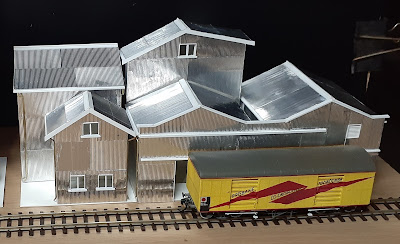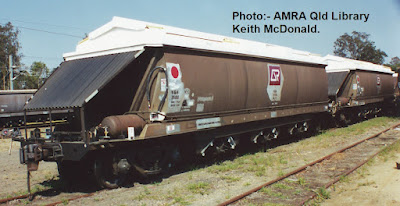On the other end of the layout, real estate has been ear marked for a flour mill.
Looking around there was not a lot of flour mills on the QR network. In Brisbane I can think of three, the mostly known one being the Albion mill which is long gone.
Other mills were at Clapham and Moolabin. All were served by rail receiving grain from the Darling Downs. By the mid 1990’s shunting of these siding ceased. A grain handling facility was established on the western end of Wacol yard there the wagon repair shop was located. A number of small corrugated silos were erected around a drop pit for unloading rail wagons. Trucks conveyed the grain to the various mills around town. Corn from the Kingaroy branch was also transferred to truck for Kellogg’s in Sydney from the site, something that was done at Clapham by slinging QR hopper bodies up above NSWR hoppers for unloading. Each week a full train of loaded grain was placed into a couple of siding at Wacol. During the week a couple of Rail Operators (Shunters) would unload the wagons using a shunt tractor, two/three wagons at a time to keep the silos full. If the weather was wet, one wagon at a time was unloaded, the rubber tyres on the shunt tractors would not grip the wet rail head. At the end of the week all the empty wagons were collected from various short sidings and were marshalled into a train for Toowoomba.
Around 2002 the grain wagon fleet was condensed from around 12 sets to 3 using higher capacity VGH wagons. The older QGX/QGA lower capacity wagons built for use on branch lines, along with VAOG wagons were scrapped. Super silos were established on the Downs and full trains were loaded in less than 2 hours. These silos were all on “A” class (15.75 TAL) lines. No longer were wagons being used as storage. You guessed it, wagons sitting around for a week was not a good investment. With the new arrangements, these wagons would be capable of 5 to 6 round trips a week to the port.
A quick look in the 1963 siding book shows a small number of flour mills in regional South East Queensland.
Defiance Milling Co. Toowoomba.
Queensland Co-op Milling
Association Toowoomba.
Warwick Flour Mill Coy’s
Sidiing (off Warwick Butter and Dairy Coy’s siding) Milhill.
Dicks Flour Mill (25 Chains) Bell Branch Dalby.
Like the butter factories, they too no longer operate, some of the buildings are still standing.
Defiance Milling
Toowoomba. (2024).
These photos were taken April 2024. Great old building, but much to large for a shunting layout.
In 2004 I visited Dalby and took a few photos of the flour mill on the Bell Branch. There was a great pie shop over the road and when passing through Dalby it was worth a few minute to stop for a coffee and a pie.
The line on the
left is the Bell Branch.
Changing the subject a little bit, talking of the Bell Branch, how about this for a prototype shunting layout. The 1963 siding book shows the following.
0 mileage being the branch points Dalby
yard.
25 Ch, – Dicks Flour Mill Siding. (Loop Siding 5½ chains.)
31 Ch. – Mobil Oil Co (Dead End 2 ch.)
46 Ch. – Beelbee Sawmilling Coy. Pty Ltd
(Loop 10 ch.) Part owned by State Wheat Board. There was also a telephone to
Dalby at the location.
54 Ch. – B.P. Coy’s Siding (Dead End 3 ch.)
63 Ch. – Phillips Oil Products Ltd
Siding (Dead End 3 ch.)
68 Ch. – Golden Fleece Petroleum Siding
(Dead End 2 ch.)
A bit further down the line was
Bonyumba
Sanatorium
Mocatta’s Corner (8 ch. loop also used by Caltex Oil Coy.).State Wheat Board 20 T cart weighbridge
Drawing suggest not all dead end siding faced the same direction.
If I’m correct, a chain is the length of a crick pitch (66 ft.)
There is an article on the shunting the branch in an ARHS publication.
DH 58 shunting the Bell Branch Dalby. The tank wagon in the siding is a BP wagon.
With consideration, the Dalby mill was the one to be built for the layout. The photos above didn’t give much from the rail side of the mill. A search on Google maps can up with a view I could use. The mill had been repainted in parts, the brown was now cream. To add a bit of colour to the layout, the mill was built as per my photos above.
I again visited the mill
after building the model and took these photos of the rail side. A very
different story, it look like a rubbish tip and things were starting to fall
apart.
Dalby Flour
Mill 1935. (Photo State Library
Queensland. Allan Queale Album)
During this era, wheat
arrived in bags, trapped wagon placed on the approach to the mill.
Around 1953, wheat transport transferred to bulk. Slios were used to store the grain. At first, it looks like two concrete silos were built and in later two steel siloes were added.
A quick look on the internet shows Dalby had a population of 1416 people in 1901. The town had a Post & Telegraph Office, School of Arts, hospital, railway station, three churches, Salvation Army Barracks, state buildings, a flour mill that had just been established along with the Farmer’s Cooperative with a Butter, Cheese and Ice Factory.
Model.
The building is to be low
relief, to set a scene for placement (spotting) of wagons. The actual mill
takes up just about a full street block with two frontages, I have allocated
400 x 75 mm ????? Best of luck old boy.
The styrene was
covered with homemade corrugated iron.
The grain silos
were made from PVC pipe purchased from Bunnings. (69 mm O/D)
The wire was to
support the cover over the unloading pit.
Styrene and
corrugated iron used in the building construction was use for the elevator
tower.
Styrene sheet and strip was used for the awning to the cover the unloading pit.
Structure ready
for painting. Some of the roof section were made removable for lighting to be
added.
The structure was painted with an airbrush using Vallejo paints much the same as in the photos taken in 2004.
Lights were added to the elevator and a flashing red light on top.
The “Flour
Mill” sign on the roof was homemade Inkjet decal.
The sign
provides identification for someone not familiar to the layout.
More lights
were added under awning and in the building. Detail was added at the open door.
The forklift, bags and pallet are InFront Models kits.
Defiance Flour wagon is a Caintode Flats “C” wagon kit. The decal is available from Ted’s Decals, check out QR’s decal set on eBay or email teditor@bigpond.com
The ARHS Sunshine Express showed a photo of the wagon and indicated the wagon as C 5626 and was painted 1946. History Card shows the wagon was built by Toowoomba Foundry Co. in Nov 1899. At first was altered for Zillmere Hams and Bacon Traffic and then used by Hutton’s for bacon traffic in 1942. Refitted back to an ordinary “C” wagon in September 1946 and sent to Mayne for the Advertising Branch. In 1951 the G.M. Brisbane issued instruction for the wagon to repainted with “Defiance Flour” signage. July 1960 the sign was deleted and applied to C 1056. C 5626 was scrapped in the Northern Division in Dec 1972.
C1056 was built by
Shillito & Son in February 1915. At first it was used as a Camp Wagon in the
Hughenden district by a Flying Gang. 1954 not shown as a Camp Wagon and found
in general traffic in Cairns. The wagon was repaired by CEC (Commonwealth
Engineering Co) in April 1959.
July 1960 the Defiance Flour advertisements was painted on the wagon in Brisbane. The wagon was scrapped at Ipswich 1985. Nothing to show when the sign was removed, my guess the wagon would have been paint “Freight Grey” during a workshop visit after 1969. I recall seeing a “Defiance Flour” wagon in the early 1960’s.
I don’t think the wagon
was captive to Defiance Flour traffic, I remember seeing the wagon out at
Charleville on a goods train. I don’t think there would be to many wanting 12
ton of flour in one order in the west, may be the local bake house.
Overall I feel the Flour
Mill feel has been captured and will provided two points for wagon placement
during operations. Maybe the taller
building at the back could have been a little taller?? I was trying to keep the
overall height down for transporting the layout.
Wagons.
Wheat arriving.
Before the mid 1950’s,
wheat was transported in bags, open and platform wagons were used. W and MTW platform
wagons were the main stay in the wheat traffic. Open wagon could also be used
as seen in the 1935 photo of the mill.
This HJS wagon was scratchbuilt using styrene, side detail was not required as the tarp covers the sides. Caintode Flats bogies and detailing parts were used.
Around 1953, wheat
transport went bulk in special open wagons covered with tarps. WH and then WHE
wagons were used.
This WH wagon
was scratchbuild from styrene.
The slightly
higher capacity WHE wagon is a PGC kit.
From the mid 1960’s bottom discharge wagons came into service, QGX wagons. If it was a bumper crop, coal wagons covered with a taps were used as well.
Only around 12
to 16 had the signage on the side. Dalby
2004.
For me, I will be using my two QGX wagons and maybe WH and WHE wagons.
This QGX wagon
is a PGC kit
Bags of Flour out.
With our flour mill owner being a very happy rail customer the end product would leave the mill in box wagons. Any four or eight wheeled box wagon could be used. Most of the time they would be supplied empty on request. From time to time one may arrive loaded with bags etc.
Overall, I think the structure will provide atmosphere for the operations required. When the structure goes on the layout some additional weathering and effects will be added.
In the meantime until we meet again, have fun and enjoy the hobby.
Arthur H.
Acknowledgements
AMRA Qld. Library.
Queensland State Archives
QR Stations, Stopping Places and Isolated Siding 3rd January 1963.







































You captured the mill quite well Arthur, and I think your reasoning for reduced height silos for easier transport, is correct.
ReplyDeleteThank You, I appreciate your comments greatly.
DeleteGreat job Arthur! I really enjoyed this post. Great read!
ReplyDeleteThanks Phillip, great you found the post interesting. Your comments are much appreciated. Arthur.
ReplyDeleteAmazing modelling Arthur, and a great read.
ReplyDeleteThanks Tony, I appreciate your comments and encouragement.
DeleteArthur, I was thrilled to see your model of the mill and the photos. My distant relative, James Dick built the mill in 1912. "Four Mill. — Mr. James Dicks [sic] new flour mill is fast nearing completion. He has been moved from the railway station yards to opposite the present hospital. This was necessary in order to obtain room for the proposed railway station improvements which the majority of the Dalby people refused to accept. Now they have to be content with matters in the same condition as they have been for the past 40 years." Darling Downs Gazette 14 Dec 1912. I hope this adds a little to the history of the mill.
ReplyDeleteThank you, awesome to hear about your family being involved in the mill in the early days. It all helps setting the scene and in putting the picture together. Very much appreciated.
ReplyDeleteArthur.